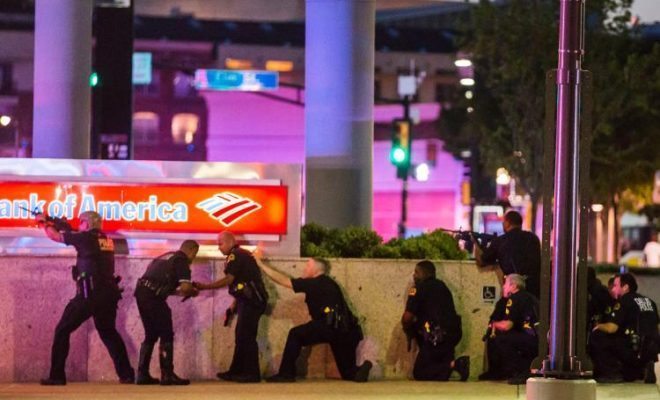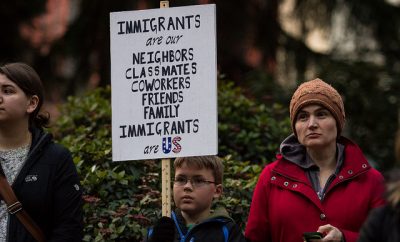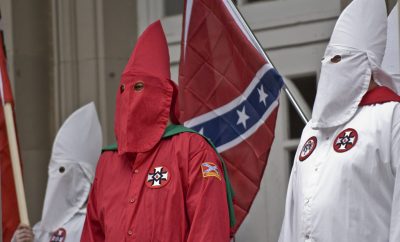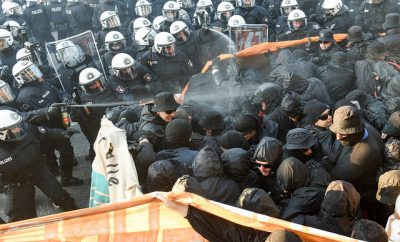 Image Courtesy of [tiocfaidh ar la 1916 via Flickr]
Image Courtesy of [tiocfaidh ar la 1916 via Flickr]
Crime
Nightmare in Dallas: What You Need to Know
It has been a long, bloody week in America. Following the killing of two black men by police in Louisiana and Minnesota earlier this week, protests sprung up across the country. In Dallas on Thursday night, a peaceful protest turned violent when shots rang out at about 8:45 pm. As a fuller picture of what happened develops over the coming days, read on for details on what we know, what we don’t know, and how Thursday’s tragic episode fits into a larger historical perspective.
What Happened
Five police officers were killed, and seven others were wounded. Two civilians were shot as well. As the Dallas police conduct their investigation, information surrounding the shooting is slowly trickling in. Reports indicate one of the shooters was killed in a parking garage in an overnight standoff with SWAT forces after negotiations failed. He has been identified as Micah Johnson, 25, and a resident of Dallas. The Dallas police chief told reporters on Friday that Johnson, during the standoff in the parking garage, said he was upset about recent events in Louisiana and Minnesota, and he “wanted to kill white people, especially white officers.”
The police detonated an explosive device that was connected to a robot, enabling them to kill Johnson while preserving their own safety. He said he acted alone, not on behalf of any group. But it is unclear if he had any assistance from any of the other suspects at this time. He also told officers that there were explosive devices he planted in the area. Officers are conducting explosive sweeps of the Dallas area.
According to a statement by the Dallas Police Department, the gunfire was delivered from an “elevated position.” Aside from the suspect that was killed by the explosive device, police have three other suspects in custody. In the hours after the chaos on Thursday night, police mistakenly identified a man in a camouflage shirt as a suspect. After hearing he was wrongly suspected, Mark Hughes turned himself in to clear up any confusion before the situation escalated.
What We Don’t Know
Many pieces to the puzzle of what happened Thursday night in Dallas are still missing. Five officers have been killed as of Friday morning, but that figure could rise as the seven who were wounded undergo treatment. It is also unclear how many shooters were involved in the attack–aside from one man who was killed overnight in a standoff with a SWAT team–or if they were coordinated or premeditated. Follow Law Street’s Twitter account to keep up to date with the story as it develops.
A Tense Time for Police and Communities of Color
This attack comes during a period in which the relationship between the police and African American communities is particularly strained. On Tuesday, Alton Sterling was shot and killed at close range by police officers in the process of arresting him. The incident was captured on video and sparked protests nationwide. Then on Wednesday, a police officer in Minnesota shot and killed Philando Castile at a traffic stop. Diamond Reynolds, Castile’s girlfriend who was in the car with him, says that Castile told the officer he had a licensed firearm but was shot while he was reaching for his wallet. Reynolds started live-streaming the immediate aftermath of the shooting on Facebook, prompting even greater outrage.
The Black Lives Matter protest in Dallas on Thursday was a response to these deaths and a continuation of recent efforts to address police violence in minority communities. So far, all accounts suggest that the rally was peaceful before the shooting broke out.
The Dallas Police Department’s Twitter account chronicled the protests as it moved through the downtown area:
Men, women, boys & girls gathered @ Belo Garden Park for the demonstration re: recent police involved shootings. pic.twitter.com/gah2Q3tqG6
— Dallas Police Depart (@DallasPD) July 8, 2016
At a press conference after the shooting, Dallas Mayor Mike Rawlings mourned the loss of the officers and highlighted the police department’s recent efforts to improve relations with the community. He said, “This police department trained in de-escalation far before cities across America did it. We are one of the premier community policing cities in the country and this year we have the fewest police officer related shootings than any large city in America.” He also noted that so far there was no indication that the violence was related to the protesters.
The Deadliest Incident in Over a Decade
The shooting in Dallas marks the deadliest incident for police officers since the attacks on September 11, 2001. According to preliminary statistics released by the FBI, there were 42 felonious officer deaths in 2015. Last night’s incident alone amounts to more than 10 percent of last year’s total.
The Officer Down Memorial Page, which tracks police officer deaths throughout the year, recorded 21 deaths from gunfire in 2016 prior to the killings in Dallas. Over the past 10 years, the number of felonious police officer deaths has generally trended downward.
Available evidence does not suggest that violence against the police has increased in recent years as police officers face heightened scrutiny. While the number of felonious deaths tends to fluctuate from year to year, the best way to measure violence against the police is with the FBI’s assaults in the line of duty statistics. The FBI plans to release data for the 2015 calendar year later this fall.
Read More: What We Know About Officer Deaths in the Line of Duty
Read More: Law Street Media’s Police in America 2016 coverage
Kevin Rizzo also contributed to this article.








Comments